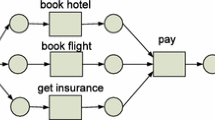Abstract
Process mining techniques attempt to extract non-trivial knowledge and interesting insights from event logs. Process mining provides a welcome extension of the repertoire of business process analysis techniques and has been adopted in various commercial BPM systems (BPM∣one, Futura Reflect, ARIS PPM, Fujitsu, etc.). Unfortunately, traditional process discovery algorithms have problems dealing with less-structured processes. The resulting models are difficult to comprehend or even misleading. Therefore, we propose a new approach based on trace alignment. The goal is to align traces in a way that event logs can be explored easily. Trace alignment can be used in a preprocessing phase where the event log is investigated or filtered and in later phases where detailed questions need to be answered. Hence, it complements existing process mining techniques focusing on discovery and conformance checking.
Access this chapter
Tax calculation will be finalised at checkout
Purchases are for personal use only
Preview
Unable to display preview. Download preview PDF.
Similar content being viewed by others
References
van der Aalst, W.M.P., Weijters, A.J.M.M., Maruster, L.: Workflow mining: Discovering process models from event logs. IEEE Transactions on Knowledge and Data Engineering 16(9), 1128–1142 (2004)
Waterman, M.S.: Introduction to Computational Biology: Maps, sequences and genomes. Chapman & Hall/CRC (2000)
Needelman, S., Wunsch, C.: A general method applicable to the search for similarities in the amino acid sequences of two proteins. Journal of Molecular Biology 48, 443–453 (1970)
Durbin, R., Eddy, S., Krogh, A., Mitchison, G.: Biological Sequence Analysis: Probabilistic models of proteins and nuclei acids. Cambridge University Press, Cambridge (2002)
Wang, L., Jiang, T.: On the complexity of multiple sequence alignment. Journal of Computational Biology 1(4), 337–348 (1994)
Bose, R.P.J.C., van der Aalst, W.M.P.: Context aware trace clustering: Towards improving process mining results. In: Proceedings of the SIAM International Conference on Data Mining, pp. 401–412. SDM, Philadelphia (2009)
Simonsen, M., Mailund, T., Pedersen, C.N.S.: Rapid neighbor-joining. In: Algorithms in Bioinformatics, pp. 113–122 (2008)
de Medeiros, A.K.A., van der Aalst, W.M.P.: Process mining towards semantics. In: Advances in Web Semantics-I, pp. 35–80 (2008)
Bose, R.P.J.C., van der Aalst, W.M.P.: Abstractions in process mining: A taxonomy of patterns. In: Dayal, U., Eder, J., Koehler, J., Reijers, H.A. (eds.) BPM 2009. LNCS, vol. 5701, pp. 159–175. Springer, Heidelberg (2009)
Song, M., van der Aalst, W.M.P.: Supporting process mining by showing events at a glance. In: Proceedings of the 17th Annual Workshop on Information Technologies and Systems (WITS), pp. 139–145 (2007)
Rozinat, A., van der Aalst, W.M.P.: Conformance checking of processes based on monitoring real behavior. Information Systems 33(1), 64–95 (2008)
Feng, D., Doolittle, R.: Progressive sequence alignment as a prerequisite to correct phylogenetic trees. Journal of Molecular Evoluation 25, 351–360 (1987)
Feng, D., Doolittle, R.: Progressive alignment of amino acid sequences and construction of phylogenetic trees from them. Methods in Enzymology 266, 368–382 (1996)
Barton, G., Sternberg, M.: A strategy for rapid multiple alignment of protein sequences, confidence levels from tertiary structure comparisons. Journal of Molecular Biology 198(2), 327–337 (1987)
Daniel, C., Paul, D., Vidhya, M., Marco, O., Eun-Jong, H., Yaoyu, W., Shyamal, S., Brian, C., Shobha, P., Enoch, H.: PFAAT version 2.0: A tool for editing, annotating, and analyzing multiple sequence alignments. BMC Bioinformatics 8(1), 381 (2007)
Author information
Authors and Affiliations
Editor information
Editors and Affiliations
Rights and permissions
Copyright information
© 2010 Springer-Verlag Berlin Heidelberg
About this paper
Cite this paper
Jagadeesh Chandra Bose, R.P., van der Aalst, W. (2010). Trace Alignment in Process Mining: Opportunities for Process Diagnostics. In: Hull, R., Mendling, J., Tai, S. (eds) Business Process Management. BPM 2010. Lecture Notes in Computer Science, vol 6336. Springer, Berlin, Heidelberg. https://doi.org/10.1007/978-3-642-15618-2_17
Download citation
DOI: https://doi.org/10.1007/978-3-642-15618-2_17
Publisher Name: Springer, Berlin, Heidelberg
Print ISBN: 978-3-642-15617-5
Online ISBN: 978-3-642-15618-2
eBook Packages: Computer ScienceComputer Science (R0)




